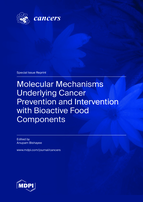Molecular Mechanisms Underlying Cancer Prevention and Intervention with Bioactive Food Components
A special issue of Cancers (ISSN 2072-6694). This special issue belongs to the section "Molecular Cancer Biology".
Deadline for manuscript submissions: closed (30 June 2022) | Viewed by 55489
Special Issue Editor
Interests: bioactive natural compounds; cancer prevention; phytopharmacology; molecular mechanisms
Special Issues, Collections and Topics in MDPI journals
Special Issue Information
Dear Colleagues,
Cancer is the second leading cause of death in the world, and it represents a major health challenge. According to GLOBOCAN (International Agency for Research on Cancer), more than 19 million new cancer cases and nearly 10 million cancer deaths occurred in 2020. The overwhelming evidence based on preclinical and clinical studies clearly indicates that diet can affect cancer outcome. Natural dietary bioactive compounds present in fruits, vegetables, spices, whole grains, and herbs have shown enormous potential for cancer prevention and treatment due to their easy availability, relatively low cost, high margin of safety, widespread acceptability, and human consumption. It has been estimated that high dietary consumption of fruits and vegetables (more than 400 g/day) may prevent at least 20% of all cancers.
During the last few decades, an extraordinary number of bioactive food components have been investigated using cell culture assays, animal tumor models, and human subjects to understand their potential for cancer prevention and treatment. Some of the most extensively studied dietary anticancer natural compounds include curcumin (from turmeric), resveratrol (from grapes and red wine), epigallocatechin-3-gallate (from green tea), b-carotene (from carrots), genistein (from soybean), quercetin (from caper), lycopene (from tomatoes), ellagic acid (from berries and pomegranate), apigenin (from chamomile), luteolin (from celery), lupeol (from mango), capsaicin (from chili pepper), naringenin (from grape fruit), diallyl disulfide (from garlic), sulforaphane (from broccoli), and ursolic acid (from apples) and zerumbone (from ginger). Emerging evidence suggests that natural dietary compounds confer anticancer activities via impacting oxidative stress, inflammation, carcinogen metabolism, cell proliferation, cell cycle regulation, apoptosis, autophagy, angiogenesis, adhesion, invasion, migration, and metastasis by modulating a plethora of cell signaling molecules, mediators, and pathways.
The purpose of this Special Issue is to capture recent advances on our knowledge regarding the cancer-preventive and therapeutic efficacy of putative bioactive food components with an understanding of associated cellular and molecular mechanisms of action. Comprehensive narrative and mechanistic reviews as well as systematic reviews and meta-analyses are within the scope of this initiative. Both preclinical and clinical studies will be considered. For experimental papers, a manuscript would incorporate both in vitro and in vivo results derived from studies using only pure dietary compounds, not extracts, fractions or mixtures of natural origin. It is expected that a collection of high-quality articles from recognized experts as well as young investigators all over the world would accelerate the translational impact of mechanism-based cancer prevention and intervention using multitargeted dietary compounds and help to identify current knowledge gaps and challenges as well as direct future research.
Prof. Dr. Anupam Bishayee
Guest Editor
Manuscript Submission Information
Manuscripts should be submitted online at www.mdpi.com by registering and logging in to this website. Once you are registered, click here to go to the submission form. Manuscripts can be submitted until the deadline. All submissions that pass pre-check are peer-reviewed. Accepted papers will be published continuously in the journal (as soon as accepted) and will be listed together on the special issue website. Research articles, review articles as well as short communications are invited. For planned papers, a title and short abstract (about 100 words) can be sent to the Editorial Office for announcement on this website.
Submitted manuscripts should not have been published previously, nor be under consideration for publication elsewhere (except conference proceedings papers). All manuscripts are thoroughly refereed through a single-blind peer-review process. A guide for authors and other relevant information for submission of manuscripts is available on the Instructions for Authors page. Cancers is an international peer-reviewed open access semimonthly journal published by MDPI.
Please visit the Instructions for Authors page before submitting a manuscript. The Article Processing Charge (APC) for publication in this open access journal is 2900 CHF (Swiss Francs). Submitted papers should be well formatted and use good English. Authors may use MDPI's English editing service prior to publication or during author revisions.
Keywords
- dietary agents
- bioactive food components
- phytochemicals
- cancer prevention
- treatment
- molecular mechanisms
- proliferation
- apoptosis
- cell signaling
- in vitro
- in vivo
- in silico
- clinical studies







